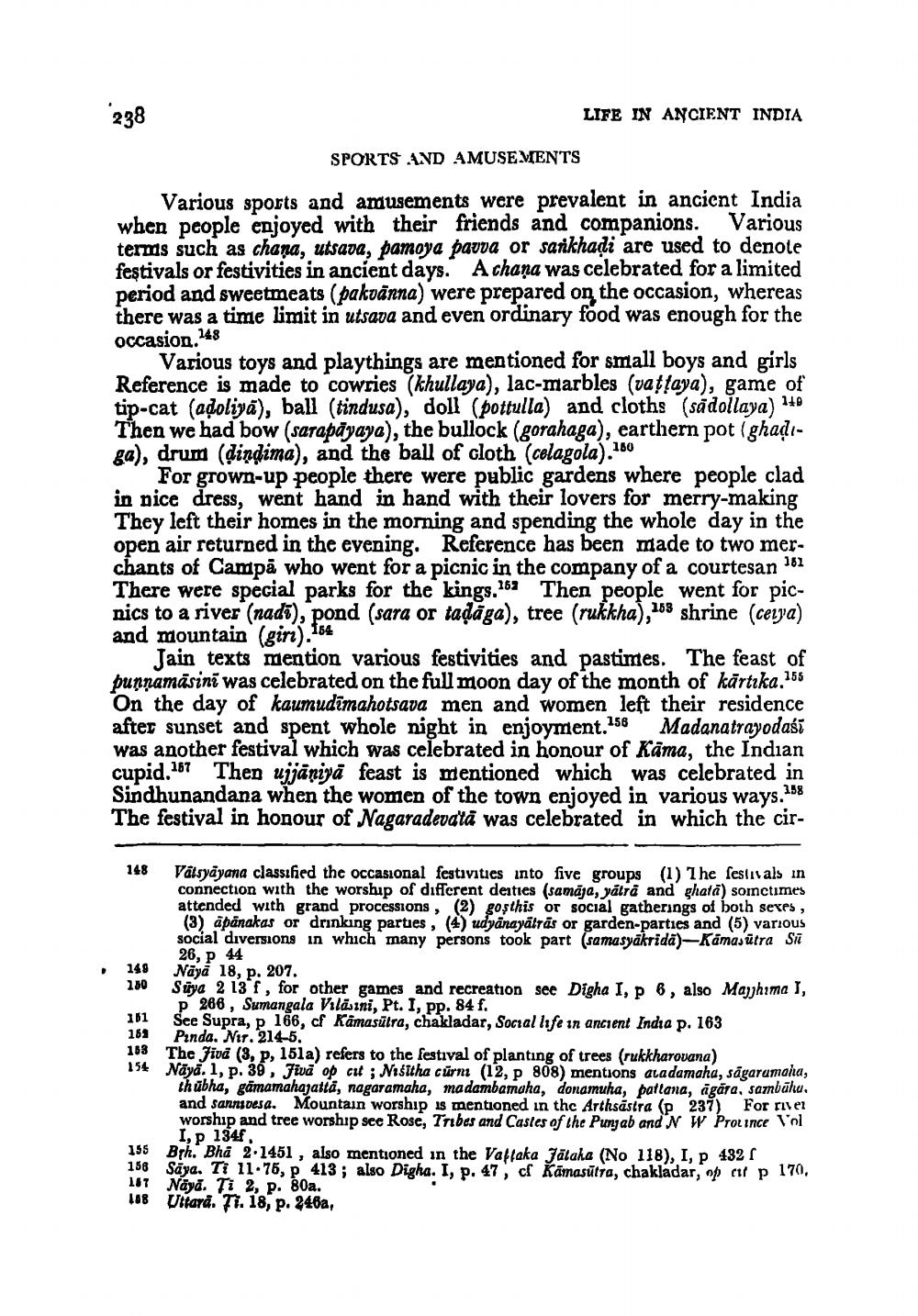________________
238
SPORTS AND AMUSEMENTS
Various sports and amusements were prevalent in ancient India when people enjoyed with their friends and companions. Various terms such as chana, utsava, pamoya pavva or sankhadi are used to denote festivals or festivities in ancient days. A chana was celebrated for a limited period and sweetmeats (pakvänna) were prepared on the occasion, whereas there was a time limit in utsava and even ordinary food was enough for the occasion.148
LIFE IN ANCIENT INDIA
Various toys and playthings are mentioned for small boys and girls Reference is made to cowries (khullaya), lac-marbles (vaṭṭaya), game of tip-cat (adoliya), ball (tindusa), doll (pottulla) and cloths (sadollaya) 1+0 Then we had bow (sarapayaya), the bullock (gorahaga), earthern pot (ghadiga), drum (dindima), and the ball of cloth (celagola)."
For grown-up people there were public gardens where people clad in nice dress, went hand in hand with their lovers for merry-making They left their homes in the morning and spending the whole day in the open air returned in the evening. Reference has been made to two merchants of Campa who went for a picnic in the company of a courtesan 151 There were special parks for the kings. Then people went for picnics to a river (nadi), pond (sara or taḍāga), tree (rukkha),153 shrine (ceya) and mountain (gir).
152
154
148
Jain texts mention various festivities and pastimes. The feast of punnamasini was celebrated on the full moon day of the month of kārtika.155 On the day of kaumudimahotsava men and women left their residence after sunset and spent whole night in enjoyment.156 Madanatrayodaśi was another festival which was celebrated in honour of Kama, the Indian cupid.17 Then ujjānijā feast is mentioned which was celebrated in Sindhunandana when the women of the town enjoyed in various ways.158 The festival in honour of Nagaradevatā was celebrated in which the cir
149
150
180
Vatsyāyana classified the occasional festivities into five groups (1) The festivals in connection with the worship of different deities (samaja, yatra and ghata) sometimes attended with grand processions, (2) gosthis or social gatherings of both sexes, (3) apanakas or drinking parties, (4) udyanayātrās or garden-parties and (5) various social diversions in which many persons took part (samasyäkridā)-Kamasutra Si 26, p 44
Nāyā 18, p. 207.
Suya 2 13 f, for other games and recreation see Digha I, p 6, also Majjhima I, P 266, Sumangala Vilasini, Pt. I, pp. 84 f.
See Supra, p 166, cf Kamasutra, chakladar, Social life in ancient India p. 163 Pinda. Nır. 214-5.
151
152
153
The Jivd (3, p, 151a) refers to the festival of planting of trees (rukkharovana) 154 Naya. 1, p. 39, Jiva op cat; Nisitha curm (12, p 808) mentions atadamaha, sagaramaha,
thubha, gamamahagatta, nagaramaha, madambamaha, donamuha, pattana, agára, sambāku. and sannivesa. Mountain worship is mentioned in the Arthsästra (p 237) For river worship and tree worship see Rose, Tribes and Castes of the Punjab and N W Province Vol I, p 134f,
155 Bth. Bha 2-1451, also mentioned in the Vattaka Jätaka (No 118), I, p 432 [ 158 Saya. Ti 11-75, p 413; also Digha. I, p. 47, cf Kamasutra, chakladar, op eit p 170, 167 Naya. Ti 2, p. 80a.
148 Uttara. Ti. 18, p. 246a,




